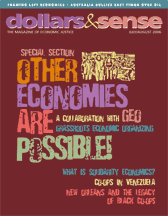COLORS Restaurant
A new democratic worker-cooperative challenges the industry
This article is from the July/August 2006 issue of Dollars & Sense: The Magazine of Economic Justice available at http://www.dollarsandsense.org

This article is from the July/August 2006 issue of Dollars & Sense magazine.
Subscribe Now
at a discount.
In the fall of 2005, COLORS restaurant opened in the heart of Greenwich Village, in New York City. In an elegant setting with Bauhaus and Art Deco touches, COLORS offers a creative seasonal menu based on favorite family recipes of its staff, who hail from 22 countries.
More than an excellent restaurant, however, COLORS is one part of a labor struggle to revolutionize the New York restaurant industry (see "Immigrant Restaurant Workers Hope to Rock New York," Dollars & Sense, Jan/Feb 2004). The restaurant is a democratic worker cooperative, founded by former workers of the Windows on the World restaurant (located on the top floor of the World Trade Center until 9-11), with help from the Restaurant Opportunities Center (ROC-NY), a workers' center established in 2002.
New York's famed restaurant industry is built on exploited immigrant labor, according to a study commissioned by ROC-NY. Only 20% of restaurant jobs pay a livable wage of $13.47 an hour or higher. Ninety percent of workers have no employer-sponsored health coverage. Immigrants of color are usually in low-paying back house jobs like dishwasher, food preparer, and line cook. Thirty-three percent of those surveyed "reported experiencing verbal abuse on the basis of race, immigration status, or language." Other illegal labor practices are common, such as work "off the clock," overtime, and minimum-wage violations, and health and safety code violations.
COLORS aims to be different. The minimum salary for back house worker-owners is $13.50 an hour. Front house worker-owners are paid minimum wage plus tips. Tips are split more equitably among the various occupations than the industry standard. In addition, every worker-owner has a benefits package that includes health insurance, paid vacation, and a pension.
Worker-owner Rosario Ceia, a 10-year veteran of the restaurant industry, says working at COLORS has been a radical change. Besides providing fair wages and benefits to worker-owners, COLORS is democratically organized into eight teams based on occupation—managers, line cooks, prep cooks, waiters, back waiters ("bus boys"), runners, dishwashers, and hosts. Each team has a representative on the board of directors. Rosario is not only a back waiter, but also treasurer of the board. Everyone participates in decision-making, Rosario emphasized, from adopting bylaws to choosing the restaurant's design.
Those in management, such as the executive chef, general manager, and wine director, play typical roles in providing needed expertise to the restaurant. In their day-to-day relationship with the other worker-owners, though, they are teammates, not bosses. As an additional safeguard against abusive hierarchy, all non-management worker-owners belong to the Hotel and Restaurant Employees Union (HERE).
Rosario believes COLORS will benefit all restaurant workers—not only by providing a successful model of "high road" business practices, but by actively advocating for workers in restaurant owners' association meetings. COLORS also extends its values down the supply chain by supporting fair trade, sustainable agriculture, and local producers.
The venture is also revitalizing an old labor organizing strategy of developing democratic worker cooperatives. The first union in the United States, Knights of Labor, wanted "to establish cooperative institutions such as will tend to supersede the wage-system, by the introduction of a cooperative industrial system." Perhaps, in addition to challenging an industry, COLORS is modeling a "new" organizing strategy for the 21st-century U.S. labor movement.
